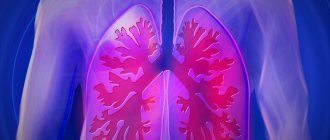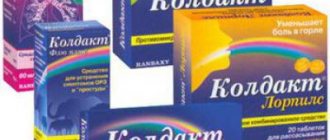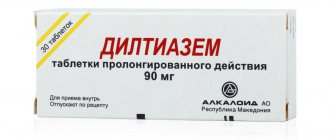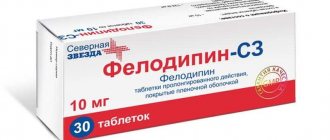Release form and composition
The following dosage forms of Coldact flu plus are produced:
- The suspension is orange in color and has a characteristic odor (in 60 ml bottles, with a dosing spoon included, 1 set in a cardboard pack);
- Capsules are gelatin hard, size “0”, with a transparent body and a red cap; inside they contain yellow, from orange to red and white or almost white pellets (in blisters of 10 pcs., in a cardboard pack 1 or 10 blisters).
Active ingredients:
- In 5 ml of suspension: phenylephrine hydrochloride – 5 mg, paracetamol – 125 mg, chlorphenamine maleate – 2 mg;
- In 1 capsule: paracetamol – 200 mg, phenylephrine hydrochloride – 25 mg, chlorphenamine maleate – 8 mg.
Auxiliary components:
- Suspension: microcrystalline cellulose (MCC), methyl parahydroxybenzoate, sodium saccharinate, propyl parahydroxybenzoate, sodium chloride, disodium edetate, xanthan gum, colloidal silicon dioxide, sucrose, sodium citrate, glycerin, sodium carmellose, citric acid, polysorbate 20, raspberry flavor (502700C), pineapple (503092С) and orange (051941CS2), sunset yellow dye, purified water;
- Capsules: ethylcellulose, talc, sodium disulfide, hypromellose, disodium edetate, diethyl phthalate, purified water, povidone, MCC, isopropanol, sunset yellow dye, quinoline yellow and crimson (Ponceau 4 R), Non Pariel Seeds 18/22 granules (sugar granules - starch syrup, sucrose).
Composition of the capsule shell: crimson dye (Ponceau 4R) and azorubine, gelatin, methyl parahydroxybenzoate, purified water, propyl parahydroxybenzoate.
Coldact Flu Plus caps. extended No. 10 35790
Description
Capsules are hard gelatin, with a red cap and a transparent body, size “0”, containing white or almost white, yellow and orange to red pellets. An orange suspension with a characteristic odor. A combined preparation of prolonged action. Chlorphenamine has an antiallergic effect, eliminates lacrimation, itching in the eyes and nose. Paracetamol has an antipyretic and analgesic effect: it reduces the pain syndrome observed during colds - sore throat, headache, muscle and joint pain, and reduces high fever. Phenylephrine has a vasoconstrictor effect - it reduces swelling and hyperemia of the mucous membranes of the upper respiratory tract and paranasal sinuses. Without a doctor's instructions, the drug should not be used by patients undergoing treatment with other medications, in particular MAO inhibitors. If, despite taking the drug, the disease is accompanied by ongoing fever or repeated increases in temperature are observed, you should consult a doctor. Do not take with alcohol or combine with other drugs containing paracetamol. When using Coldact® Flu Plus, it is not advisable to use sleeping pills, tranquilizers and other psychotropic drugs. Distorts laboratory test results in the quantitative determination of glucose and uric acid in plasma. In case of long-term treatment, peripheral blood parameters and the functional state of the liver are monitored. During the treatment period, it is necessary to refrain from driving vehicles and engaging in potentially hazardous activities that require increased concentration and speed of psychomotor reactions.
Compound
Extended-release capsules 1 capsule. chlorphenamine maleate 8 mg paracetamol 200 mg phenylephrine hydrochloride 25 mg excipients: talc; hypromellose; ethylcellulose; diethyl phthalate; MCC; povidone; purified water*; isopropanol*; sodium disulfite; disodium edetate; crimson dye (Ponceau 4 R); sunset yellow dye; quinoline yellow dye; granules Non Pariel Seeds 18/22 (sugar granules: sucrose, starch syrup) capsule shell: gelatin; purified water; methyl parahydroxybenzoate; propyl parahydroxybenzoate; Azorubine dye; crimson dye (Ponceau 4R) * lost during the production process in a blister of 10 pcs.; in a cardboard pack there are 1 or 10 blisters. Oral suspension 5 ml chlorphenamine maleate 2 mg paracetamol 125 mg phenylephrine hydrochloride 5 mg excipients: methyl parahydroxybenzoate; propyl parahydroxybenzoate; sodium saccharinate; disodium edetate; sodium chloride; sucrose; MCC; carmellose sodium; xanthan gum; glycerol; colloidal silicon dioxide; polysorbate 20; lemon acid; sodium citrate; sunset yellow dye; orange flavor (051941CS2); raspberry flavor (502700С); pineapple flavor (503092С); purified water in a 60 ml bottle (complete with dosing spoon); 1 set in a cardboard pack.
Application
Symptomatic treatment of colds, flu, acute respiratory viral infections (fever, pain, rhinorrhea). Coldact® Flu Plus is not recommended for use during pregnancy and lactation. Increased blood pressure, tachycardia, drowsiness, difficulty falling asleep, dizziness, increased excitability, dry mucous membranes, mydriasis, accommodation paresis, increased intraocular pressure, loss of appetite, nausea, epigastric pain, anemia; very rarely - urinary retention, allergic reactions (skin rash, itching, urticaria, angioedema), rarely - anemia, thrombocytopenia, leukopenia, agranulocytosis; with long-term use in high doses, hepatotoxic and nephrotoxic effects are possible. The risk of developing the hepatotoxic effect of paracetamol increases with the simultaneous administration of barbiturates, diphenine, carbamazepine, rifampicin, zidovudine and other inducers of microsomal liver enzymes. Enhances the effects of sedatives, ethanol, and monoamine oxidase inhibitors. Antidepressants, phenothiazine derivatives, antiparkinsonian and antipsychotic drugs increase the risk of developing urinary retention, dry mouth, and constipation. GCS increase the risk of developing glaucoma. Paracetamol reduces the effectiveness of uricosuric drugs. Chlorphenamine combined with furazolidone can lead to hypertensive crisis, agitation, and hyperpyrexia. Tricyclic antidepressants enhance the adrenomimetic effect of phenylephrine; simultaneous administration of halothane increases the risk of developing ventricular arrhythmia. Reduces the hypotensive effect of guanethidine, which, in turn, enhances the alpha-adrenergic stimulating activity of phenylephrine. Orally. Capsules Adults and children over 12 years old, 1 capsule. every 12 hours for 3–5 days. Shake the suspension before use. For adults and children over 12 years old - 10 ml (2 teaspoons) 3-4 times a day, for children 6-12 years old - 5 ml (1 teaspoon) 3-4 times a day. Duration of use as an antipyretic is no more than 3 days; as an analgesic - no more than 5 days. Symptoms: caused by paracetamol, appear after taking more than 10-15 g - pallor of the skin, decreased appetite, nausea, vomiting, hepatonecrosis, increased activity of liver transaminases, increased PT. Treatment: gastric lavage in the first 6 hours, administration of SH-group donors and precursors for the synthesis of glutathione - methionine within 8-9 hours after an overdose and N-acetylcysteine - within 12 hours. In case of accidental overdose, you should immediately consult a doctor, regardless of whether , whether there are any symptoms of overdose or not. Common to both dosage forms: hypersensitivity to any of the components included; severe atherosclerosis of the coronary arteries; arterial hypertension; diabetes; angle-closure glaucoma; peptic ulcer of the stomach and duodenum; pancreatic diseases; difficulty urinating with prostate adenoma; deficiency of the enzyme glucose-6-phosphate dehydrogenase; thyrotoxicosis; severe diseases of the liver, kidneys, heart, bladder; diseases of the blood system; pregnancy; lactation period. Additionally for capsules: children under 12 years of age. Additionally for suspension: children under 6 years of age. With caution: congenital hyperbilirubinemia (Gilbert, Dubin-Johnson and Rotor syndromes), bronchial asthma and COPD.
Possible product names
- Coldact Flu Plus caps. extended No. 10
- COLDACT FLU PLUS CAPS. No. 10
- COLDACT FLU PLUS N10 CAPS PROLONG
- COLDACT FLU PLUS CAPS. PROLONG. ACTION X10 PACK (12)
- Coldact flu plus susp. fl. 60ml (04.08)
- COLDACT FLU PLUS CAPS. PROLONG. ACTION X10
- (Coldact Flu Plus) Coldact Flu Plus caps. extended No. 10
Contraindications
Tablets and suspension – hypersensitivity to the active substances and auxiliary components included in the drug.
Capsules:
- Children under 12 years of age;
- Diabetes;
- Angle-closure glaucoma;
- Thyrotoxicosis;
- Arterial hypertension;
- Severe atherosclerosis of the coronary arteries;
- Diseases of the blood system;
- Peptic ulcer of the stomach and duodenum;
- Severe diseases of the heart, liver, bladder, kidneys;
- Difficulty urinating with prostate adenoma;
- Diseases of the pancreas;
- Glucose-6-phosphate dehydrogenase deficiency.
Suspension: children under 6 years of age, pregnancy, breastfeeding period.
Carefully:
- Capsules: bronchial asthma, congenital hyperbilirubinemia (Rotor, Dubin-Johnson, Gilbert syndromes), chronic obstructive pulmonary disease (COPD);
- Suspension: prostatic hyperplasia, blood diseases, angle-closure glaucoma, liver and/or kidney failure, glucose-6-phosphate dehydrogenase deficiency, congenital hyperbilirubinemia, diabetes mellitus, arterial hypertension, bronchial asthma, COPD, thyrotoxicosis.
Taking Coldact flu plus capsules is not recommended during pregnancy and breastfeeding.
Directions for use and dosage
Capsules and suspension are taken orally. The suspension must be shaken before use.
Adults and children over 12 years of age take 1 capsule once every 12 hours for 3-5 days.
The dose of the suspension for children over 12 years of age and adults is 2 teaspoons (10 ml) 3-4 times a day, for children 6-12 years old - 1 teaspoon (5 ml) 3-4 times a day.
The duration of taking capsules and suspensions as an anesthetic is no more than 5 days, as an antipyretic - no more than 3 days.
Side effects
The use of Coldact flu plus suspension may cause the following side effects:
- Allergic reactions (angioedema, itching, rash, urticaria);
- Nausea, pain in the epigastric region;
- Agranulocytosis, anemia, thrombocytopenia;
- Increased excitability, increased blood pressure (BP), mydriasis, dizziness, accommodation paresis, difficulty falling asleep, dry mouth, increased intraocular pressure;
- Urinary retention.
In cases of long-term use of the suspension in large doses, aplastic anemia, hepatotoxicity, methemoglobinemia, pancytopenia, hemolytic anemia, nephrotoxicity - papillary necrosis, renal colic, interstitial nephritis, glycosuria are observed.
The following side effects may occur when using capsules:
- Drowsiness, increased blood pressure, tachycardia, dizziness, difficulty falling asleep, increased excitability, accommodation paresis, loss of appetite, anemia, dry mucous membranes, increased intraocular pressure, mydriasis, epigastric pain, nausea;
- Very rare: allergic reactions (itching, rash, angioedema, urticaria), urinary retention;
- Rarely: thrombocytopenia, anemia, agranulocytosis, leukemia;
- With long-term use in high doses: nephrotic and hepatotoxic effects.
Overdose
Symptoms of an overdose of Coldact Flu Plus are mainly caused by paracetamol and begin to appear after taking more than 10-15 g of paracetamol.
Paracetamol
In case of acute overdose, hepatotoxic effects, including liver necrosis, are observed. It is also possible to develop nephropathy with irreversible liver failure.
The severity of an overdose directly depends on the dose, so patients should be warned about the prohibition of simultaneous use of several drugs containing paracetamol. The risk of poisoning is especially high in children, the elderly, patients with liver disease, patients with chronic malnutrition, persons with chronic alcoholism and patients concomitantly taking inducers of microsomal oxidation in the liver. Paracetamol intoxication can cause bleeding, impaired glucose metabolism, pancreatitis, hypoglycemia, encephalopathy, liver failure, coma and even death.
In the first 24 hours after an overdose of paracetamol, nausea, pale skin, vomiting, convulsions and anorexia are observed. Abdominal pain may be the first sign of liver damage and usually does not appear for 1–2 days, and sometimes may appear later, after 4–6 days. On average, abdominal pain occurs 72–96 hours after an overdose. It is also possible to develop metabolic acidosis and impaired glucose metabolism, the appearance of acute renal failure and acute tubular necrosis. Cases of pancreatitis and cardiac arrhythmia have been reported.
As an antidote, the patient is administered acetylcysteine (orally or intravenously). The patient's stomach is washed and methionine is given. These measures may have an effect within 48 hours after an overdose of paracetamol. It is recommended to take activated carbon. It is advisable to monitor blood circulation and respiration. Possible convulsions are relieved with diazepam.
Phenylephrine
In case of an overdose of phenylephrine, the following symptoms occur: nausea, vomiting, dizziness, headache, decrease or increase in blood pressure, hematopoietic disorders, rash, drowsiness with subsequent anxiety (especially in children), insomnia, increased excitability, bradycardia, visual disturbances, convulsions. , coma.
Treatment consists of surgical gastric lavage and prescribing the necessary symptomatic and supportive therapy. The hypotensive effect can be stopped by intravenous administration of an alpha-receptor blocker. For convulsions, diazepam is prescribed.
Chlorphenamine
Signs of chlorphenamine overdose include: drowsiness, anticholinergic effects, convulsions, dystonic reactions, arrhythmia, cardiovascular collapse, respiratory arrest. Children may also experience agitation, behavior changes, incoordination, tremors, seizures, hallucinations and anticholinergic effects.
It is necessary to induce vomiting, and in case of massive overdose, rinse the stomach. The patient may then be given activated charcoal and a laxative to slow the absorption of chlorphenamine. Seizures are treated with intravenous phenytoin or diazepam. In severe cases, hemoperfusion is performed.
special instructions
In cases of pain lasting more than 5 days and hyperthermia for more than 3 days, consultation with a doctor is necessary.
Patients with alcoholic hepatosis have an increased risk of developing liver damage.
It should be taken into account that Koldakt flu plus distorts laboratory test results in the quantitative determination of uric acid and glucose in plasma.
During long-term treatment, it is recommended to monitor the functional state of the liver and peripheral blood parameters.
Without a doctor's prescription, the drug should not be used by patients undergoing therapy with other drugs, incl. monoamine oxidase inhibitors (MAO). In cases where, despite taking the medicine, the disease is accompanied by ongoing fever or repeated increases in temperature are observed, it is recommended to consult a doctor.
The drug should not be taken with other medications that contain paracetamol, and it is undesirable to take it with tranquilizers, sleeping pills and other psychotropic drugs.
During therapy, due to the possibility of developing hepatotoxic effects, patients should not consume ethanol. It is also recommended to refrain from engaging in potentially hazardous activities that require increased attention and speed of psychomotor reactions.
Drug interactions
With the simultaneous use of Coldact flu plus with diphenin, barbiturates, rifampicin, carbamazepine, zidovudine and other inducers of microsomal liver enzymes, the risk of developing the hematotoxic effect of paracetamol increases.
The drug enhances the effects of MAO inhibitors, ethanol and sedatives.
The risk of developing constipation, dry mouth, and urinary retention is increased by phenothiazine derivatives, antipsychotic and antiparkinsonian drugs, and antidepressants. Glucocorticosteroids increase the risk of developing glaucoma.
Paracetamol in Coldact flu plus reduces the effectiveness of uricosuric drugs.
The use of chlorphenamine in combination with furazolidone can lead to hyperrexia, agitation, and hypertensive crisis.
The adrenomimetic effect of phenylephrine is enhanced by tricyclic antidepressants. Concomitant use with halothane increases the risk of developing ventricular arrhythmia.
The drug reduces the hypotensive effect of guanethidine (in turn, enhancing the alpha-adrenergic stimulating activity of phenylephrine).
Pharmacological properties
Pharmacodynamics
Coldact Flu Plus is a long-acting combination product, the therapeutic effect of which is due to the properties of its individual components:
- paracetamol: an anilide with antipyretic and analgesic activity;
- phenylephrine hydrochloride: an alpha-adrenergic agonist that has a vasoconstrictor effect, reducing hyperemia and swelling of the mucous membrane of the nasal cavity and paranasal sinuses;
- chlorphenamine maleate: is a blocker of H1-histamine receptors, which has antiallergic activity, eliminates lacrimation, reduces the severity of local exudative effects, and relieves itching in the nose and eyes.
Pharmacokinetics
The pharmacokinetics of Coldact Flu Plus have not been described.






